Willet Pot Still Reserve Bourbon: The Ultimate Bottle Guide

Forget judging a book by its cover, what does the shape of a bottle tell us? While most whiskeys on the shelf may fill unsurprising bottle styles, Willet Pot Still Reserve's iconic copper pot sill-shaped decanter bottle begs a closer read. In fact, even first impressions of this recognizable vessel communicate a lot about this bourbon's heritage and production.
Willet Pot Still Reserve is classified as Kentucky straight bourbon whiskey, a fact stated elegantly in golden lettering. The absence of an age statement on the bottle indicates that the mahogany whiskey inside it was aged in charred new oak barrels for at least four years, and this classification means that at least one of those years has to have been in the state of Kentucky.
This small-batch product is now distilled using the copper pot still that the bottle resembles. On the nose, the bourbon offers a greeting of vanilla and some fruitier notes like lemon and cherry. The whiskey's corn content makes itself known with sweet notes of caramel, while other notes of fruit, black pepper, vanilla, and citrus also emerge on the palate. Sitting at 47% ABV (94 Proof), there is a touch of heat from the alcohol that some drinkers don't love, while others don't mind.
After working with spirits in sales, marketing, retail, and hospitality for around ten years, I've grown a love for whiskey of all expressions. I've long awaited a chance to deep dive into this memorable bourbon with this ultimate bottle guide.
Read more: The 27 Best Bourbon Brands, Ranked
History Of Willet Pot Still Reserve

The story of Willet's bourbon begins in the 1800s with John David Willet, who held the position of Master Distiller at Moore, Willet & Frenke. As the name of the distillery implies, he was also a third part owner of this business. He may not have known it at the time, but his career would start a historied line of whiskey production under his descendants right until today.
In 1936, the Willet Distillery opened in Bardstown, Kentucky on the farm site they'd been running during prohibition. This development was led by the founder and president of the distillery, Aloysius Lambert Thompson Willett (who went by the name Thompson Willet). Over the decades, the distillery released a variety of new whiskeys.
In 1984, Thompson Willet sold the distillery to his daughter Martha and her husband, Even Kulsveen. Even and Martha Willet Kulsveen still run the business, and their son Drew and daughter Britt have hopped on board with their respective partners.
In 2008, the first Willet Pot Still Reserve was released with its recognizable bottle shape, based on the blueprints of the distillery's original still. In 2012, the family opened its brand new distillery on the site, premiering its traditional copper pot still, also based on the original. It's believed that at this time, Pot Still Reserve was transitioned into being distilled entirely in-house.
What Does Willet Pot Still Reserve Taste Like?
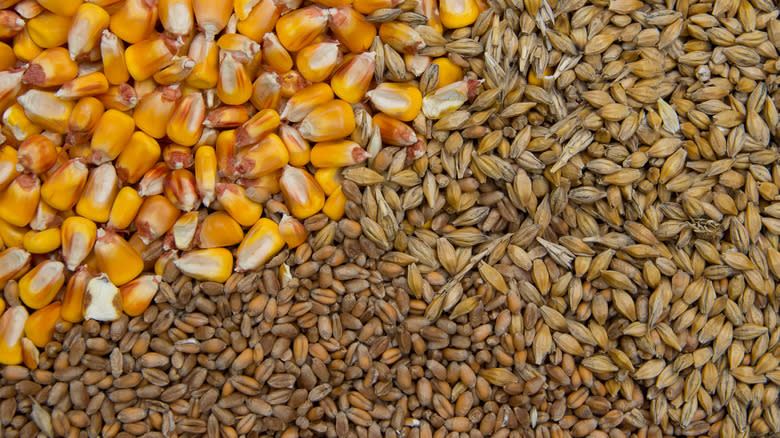
Willet's Pot Still Reserve makes its identity as a bourbon known immediately with up-front aromas of toasted corn. Supporting acts on the nose include honey, custardy vanilla, and citrus, with touches of barrel funk, cooking spice, and toasted banana for good measure.
At first sip, the bourbon greets you with a sharp black pepper bite, which levels out into a citrussy bitterness like burnt orange rind. Across the palate, the caramel sweetness of corn is soft and welcoming, further sweetened with a whisp of vanilla and candied fruit. The finish is slick and leaves behind a tannic and oak-kissed mint chocolate flavor. With a dash of water, the citrus character becomes more exaggerated and lemon-like. Similarly, the depth of the bourbon's spice character is more apparent with some dilution.
The whiskey's texture is velvety, without being overly viscous or oily. Overall, this is an intense, full-flavored, complex, and upfront bourbon with a kick of heat that eventually softens out to reveal the rest that the palate has to offer.
How Is Willet Pot Still Reserve Made?
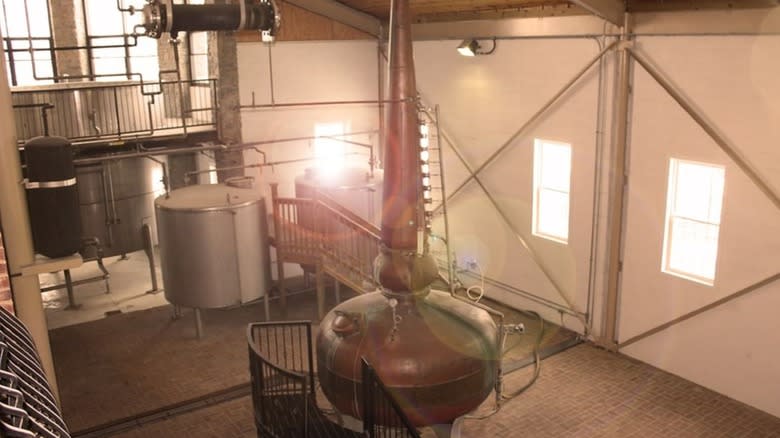
With Willet Distillery's iconic copper pot still installed since 2012, the production of this spirit has moved to being completely in-house. Prior to 2008, the bourbon was sourced from other distilleries and barreled, aged, and blended at the Willet Distillery. Despite the suggestive bottle, it has been suggested that the distillery uses a column still for the primary distillation, with the copper pot used secondarily to further distill the spirit.
Willet uses 100% new charred white oak barrels for this aging process, which imparts a bold oak influence into the spirit. The time it spends in these barrels also gives the bourbon its rich mahogany tone, further helping the bottle resemble the copper pot still. A special building on site, Warehouse A is where the bourbon is stored and aged in its barrels. The family has been aging whiskey in the same warehouse since St. Patrick's Day in 1937 and was recently renovated in 2011.
The bourbon is made from a wheated mash bill with 20% wheat lending some subtle herbaceous, even minty notes, malted barley comprises 15% of the total grains, possibly contributing to the bourbon's fruity flavors. Overshooting the bourbon category's 51% corn requirement, Pot Still Reserve comprises 65% corn, giving the spirit its sweetness and texture.
How To Drink Willet Pot Still Reserve
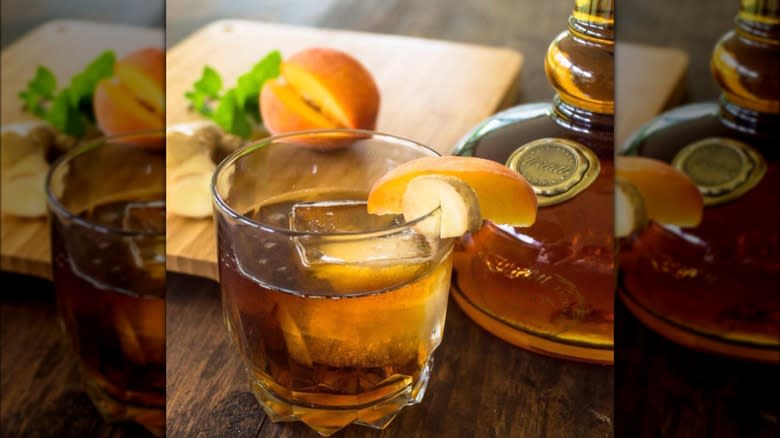
Willet Pot Still Reserve is certainly rewarding neat, and the longer you sit with it in this way, the more the flavor deepens and reveals what hides behind its hot first impression. A splash of dilution certainly helps to soften its 47% ABV and allow some of its intense citrus and spice flavors to open up.
On the rocks is also an enjoyable way to enjoy Pot Still Reserve, as the ice naturally provides the dilution that softens the intensity of the spirit. Cooling the bourbon down with ice also helps to quash some of its heat, which can come across more as a pleasant citrus sharpness when diluted. For those who enjoy bourbon, but have a low threshold for intense flavors or burn, this could be the winning method for them.
As a boldly-flavored spirit, Pot Still Reserve lends itself to bourbon-based, spirit-forward cocktails, such as an old fashioned. This is a particularly good match for this whiskey, as it offers complementary orange peel and candied fruit characteristics to match the cocktail's common garnishes. Aromatic bitters also echo the whiskey's spicier notes, as another cohesive element between the spirit and the other ingredients of the cocktail.
Pot Still Reserve's Pricing

Despite its impactful container, this is a relatively affordable bottle of high-quality bourbon, usually retailing for around $50-$55 USD, as of January 2024. The price and packaging of this product make it an appealing gifting bottle, or an impressive back-bar focal point.
Willet has produced whiskeys of around $70-$75 USD under the Willet Family Estate title, up to an average price of $39,999 per bottle for their specialty ryes that carry an age statement of 22 and 23 years. On the other end of the spectrum, Willet Distillery also produces consumer-level whiskeys that retail for as little as just under $30.
It seems that Willet places Pot Still Reserve right between these two pricing segments. This could be an attempt to offer a product that suggests premium quality with a more accessible price tag than the Willet Family Estate Range. The product's lavish pot still-shaped decanter bottle implies that its contents are hand-crafted and worth savoring. Common opinions are divided as to whether or not the packaging suggests a higher-value product than what's in the bottle.
Pot Still Reserve Vs Blanton's Bourbon
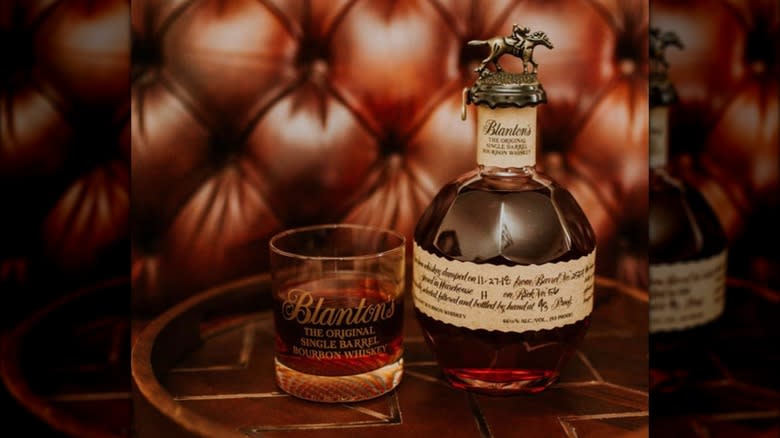
Comparison may be the thief of joy if Theodore Roosevelt is to be believed, but in an ultimate bottle guide such as this, it can be pretty useful. Weighing up the price, packaging, and quality of Pot Still Reserve with a comparable product can help get a clearer idea of how it performs on the shelf and in the glass, relative to its competitors.
Blanton's Original Single Barrel Bourbon claims to be the world's first single-barrel bourbon. This bourbon tends to end up in weigh-ins with Willet's Pot Still reserve, likely because of two main factors, its packaging, and its flavor profile.
Both Pot Still Reserve and Blanton's Original Single Barrel have unique and recognizable bottles. Blanton's bottle features a distinctive metal jockey perched atop the stopper, and the vessel itself is eye-catching, with its faceted round shape.
On the palate, Blanton's offers many of the same notes as Pot Still Reserve, including citrus and ever-present oak, with caramel and soft vanilla prominent on the nose. At 46.5% ABV, Blanton's offering is only half a percent lower than Pot Still Reserve.
Overall, Blanton's presents a higher-quality product, with a slightly longer finish, and more weight on the palate. The major difference between these two products, however, is that Blanton's is significantly more expensive, possibly because it has become so hard to find. Original Single Barrel typically retails for well over $160 per bottle, which runs at around three times the typical price for Pot Still Reserve.
Willet Became An Independent Bottler In The 1980s
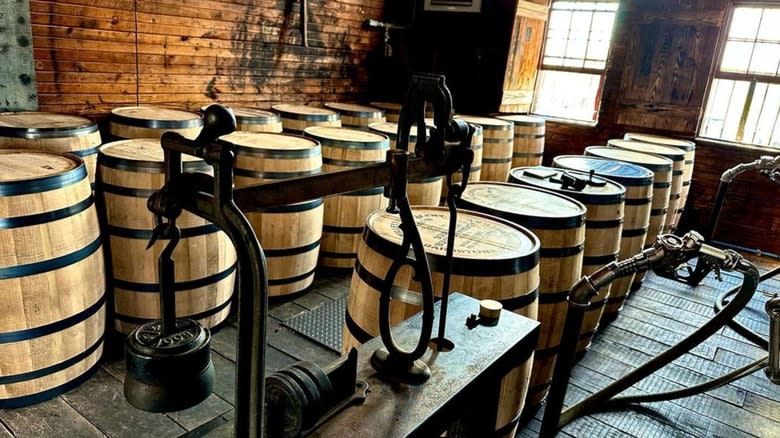
As the story goes, between 1984 and 2012, starting with the new leadership of Even Kulsveen and Martha Willet Kulsveen, the Willet Distillery ceased distilling its own spirits and became an independent bottler. During this time, the business changed its name to Kentucky Bourbon Distillers Ltd. or KBD for short.
Independent bottlers are producers who purchase barrels of whiskey and manage or complete the aging process in their own facility. They then bottle the whiskey and release it under their own name. Blending is also common practice between different casks to create the desired final product or ensure consistency.
This is how Willet produced and sold whiskey in a difficult time for the business due to lessening interest in brown spirits. Even Kulsveen had experience in export markets and saw the potential for sales overseas. The business shifted into producing desirable whiskeys through careful selection, treatment, and packaging of Kentucky Bourbon Distillers' products. This is no small task, as this requires storing the liquid in ideal conditions without aging the bourbon too long, or so short that it doesn't benefit enough from time in oak.
Now thriving in a new generation, Willet has reclaimed its name and systematically replaced sourced whiskey with whiskey produced on-site. Even's son Drew is now the current master distiller, reigniting the family's legacy as distillers.
Some Of Willet's Biggest Bourbons Use Different Names

What many bourbon lovers may not realize, is that the Willet family of brands includes several common bourbons that don't advertently feature the Willet name. Products including Johnny Drum, Rowan's Creek, Pure Kentucky, Noah's Mill, and Old Bardstown are in fact whiskeys produced by Willet Distillery. Some of these products have been a major part of the Willet family of brands for a long time, with Johnny Drum being developed and released by Thompson Willet in the 1960s.
In the 1990s, during the business' period as independent bottler Kentucky Bourbon Distillers Ltd., Rowan's Creek, Noah's Mill, and Pure Kentucky, were developed and introduced. These products are staples on bourbon shelves and even distributed internationally. The distillates' origins are not something openly disclosed for these whiskeys.
Since the distillery roared into action in 2012, these covert Willet whiskeys [Rowan's Creek, Noah's Mill, Pure Kentucky, Old Bardstown] began to transition to being distilled on-site. Through these different tiers of product, Willet occupies a broad range of price brackets, from entry-level consumer whiskeys to some of the most expensive ryes and bourbons you can buy. Bourbons such as Noah's Mill regularly appear on lists of top shelf bourbons to know about.
Willet Uses A Secret Strain Of Yeast

Now that Willet has been up and bubbling with its distillery since 2012, there are other elements of the process that give this producer more control over its product. Among discussions of pot stills and barrel aging, one aspect that can easily be overlooked is all the hard work that the yeast performs in fermenting the wort from which the whiskey is distilled in one of the facility's 10,000-gallon fermenters.
Willet proudly boasts a proprietary strain of yeast, another fact proudly stated in gold lettering on the back of the bottle. The specific strain of yeast a distillery uses can be a closely guarded secret, and information about Willets is scarce, save for this intriguing claim on the packaging.
Inside the fermenter, Willet's yeast consumes sugars from the corn, wheat, and barley to make alcohol. During this process, yeast also creates other flavoring compounds, such as those that offer fruity, herbaceous, or other complex notes. In America, it's common for distillers to refine their secret strains of yeast by breeding them to create the specific complementary flavors they desire in their whiskeys. It may well be that Willet's top-secret yeast is responsible for many of the intriguing fruit or citrus notes you can enjoy in the Pot Still reserve.
Read the original article on Tasting Table.


